Reading Comprehension - Vocabulary & Fluency
> Jrauert2019
Word Study Instruction in the K-2 Classroom. Click the "References" link above to hide these references.
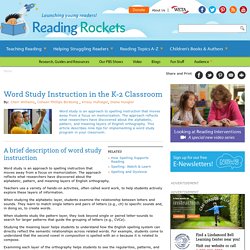
Bear, D.R., Invernizzi, M., Templeton, S., & Johnston, F. (2000). Words their way: Word study for phonics, vocabulary, and spelling instruction (2nd ed.). Upper Saddle River, NJ: Prentice-Hall. Bear, D.R., Invernizzi, M., Templeton, S., & Johnston, F. (2008). Words their way: Word study for phonics, vocabulary, and spelling instruction (4th ed.).
What Are Running Records? A Teacher Guide for Planning Instruction. Chances are, if you teach the primary grades, you have to do running records.
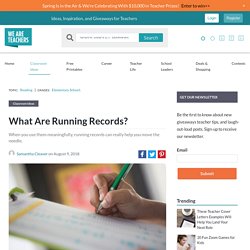
But what are running records, and how do they help you teach reading? Never fear, WeAreTeachers is here to explain it all. What are running records? Running records fall under the reading assessments portion of your readers’ workshop. They’re part read aloud assessment (think: fluency assessment) and part observation. When do I use running records? Running records are used to collect information on young readers who are still reading aloud and working on basic skills (think: those who are at reading levels aa–J).
Once you do the first running record, the time in between running records will depend on how well the child is progressing and what level they are reading.
Five Reasons Why You Should Use Reader’s Theater in the Upper Elementary Classroom — THE CLASSROOM NOOK. I’m a big proponent of using Reader’s Theater in the classroom.
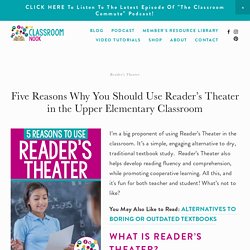
It’s a simple, engaging alternative to dry, traditional textbook study. Reader’s Theater also helps develop reading fluency and comprehension, while promoting cooperative learning. All this, and it's fun for both teacher and student! What’s not to like? You May Also Like to Read: ALTERNATIVES TO BORING OR OUTDATED TEXTBOOKS Simply put, Reader’s Theater is students reading a script adapted from literature or other subject matter, to a small group of fellow students. It’s Useful and Purposeful Reader’s Theater involves students in: Reading/Speaking – Each student prepares ahead of time, and then takes a turn acting out their portion of the prepared script. That’s a lot of direct benefits to your students (not to mention Common Core coverage) stemming from a single exercise!
It’s engaging Reader’s Theater allows students a more active role in their own education, and allows them to “act out” in a controlled, productive manner.
20 Fun Phonics Activities and Games For Early Readers - We Are Teachers. Phonics is key to helping young learners master reading and writing.
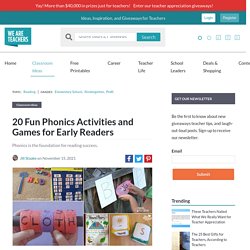
Breaking words into their constituent sounds helps kids understand and build their literacy skills, bit by bit. Phonics activities like the ones here, combined with strong sight words practice, will help build reading fluency in young students. These ideas work in the classroom or at home, so you’re sure to find several that your kids will enjoy. Wondering how you’ll do phonics activities while wearing a mask in your classroom this year? See how one teacher is planning to overcome the challenge. 1.
5 Steps to Building a Better Word Wall.
It was raining again. My second-grade students were indoors for recess and enjoying free time when a student approached me and asked, “How do I spell because?” I responded, “That’s a tricky one—have you checked the word wall?” The student answered with a familiar tune, “Oh yeah! I forget about the wall sometimes, it’s so high up.” She waltzed over to the word wall and craned her neck to find the word because written at the top of the wall, in my handwriting. A few moments later, “Mrs. For 13 years I fiddled with word wall systems, hoping to uncover one that worked for the learners in my class. Taking Action On a Monday morning soon after that rainy day, I called a class meeting to ask my students for their ideas on how to improve the word wall. Another problem was placement. My students shared many ideas during our class meeting that day. A 5-Step Process for Improving the Word Wall 1. 2.
How do students want to manage the wall? Courtesy of Justine Marie Bruyère 3. 4.
Fry Word List - 1,000 High Frequency Words. 18 Fantastic Reading Fluency Activities To Build Literacy in Young Readers. Learning to read starts kids on a lifelong learning journey, but literacy is more than just understanding the words on a page.
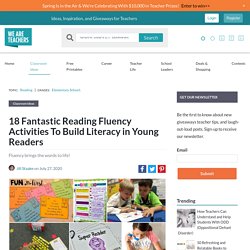
Reading fluency involves comprehension, speed, accuracy, and prosody (reading with expression). There are many ways to help kids develop reading fluency, both in and out of the classroom. Here are some of our favorites. 1. Start with a reading fluency anchor chart Introduce the basics of reading fluency with an anchor chart you can hang in the classroom.
Learn more: Teaching With a Mountain View 2. Reading aloud to kids is important for so many reasons, but one of the best is that it teaches kids what fluency sounds like. 3.





